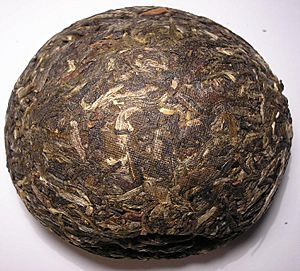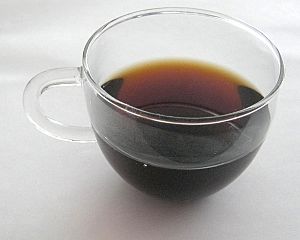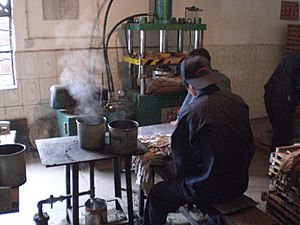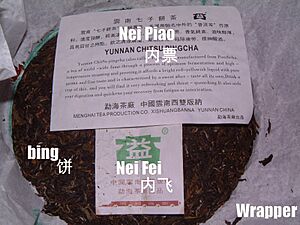Pu'er tea facts for kids
Quick facts for kids Pu'er tea |
|||||||||||||||||||||||
|---|---|---|---|---|---|---|---|---|---|---|---|---|---|---|---|---|---|---|---|---|---|---|---|

Xiaguan Te Ji (special grade) raw tuocha from 2004
|
|||||||||||||||||||||||
| Chinese | 普洱茶 | ||||||||||||||||||||||
|
|||||||||||||||||||||||
Pu'er (say "poo-air") is a special kind of fermented tea that comes from Yunnan Province in China. Unlike most teas, Pu'er goes through a process called microbial fermentation. This means tiny living things like bacteria and fungi help change the tea leaves. This process gives Pu'er its unique taste and dark color.
There are two main types of Pu'er tea:
- Raw Pu'er (called shēng chá): This tea ages slowly over many years, like a fine wine.
- Ripe Pu'er (called shóu chá): This tea goes through a faster fermentation process that makes it ready to drink much sooner.
Both types start as "rough tea" (máo chá). They can be sold loose or pressed into different shapes. People often store Pu'er tea for a long time to let it age and develop even richer flavors. This is why you'll often see the year and region where a Pu'er tea was made on its label.
Contents
- What's in a Name?
- A Look Back: Pu'er Tea History
- How Pu'er Tea is Made
- How Pu'er Tea Tastes
- Where Pu'er Tea Comes From
- How Pu'er Tea is Grown
- Pu'er Tea Grades and Seasons
- Tea Factories and Recipes
- How Pu'er Tea is Packaged
- Aging and Storing Pu'er Tea
- How to Prepare Pu'er Tea
- How to Judge Pu'er Tea Quality
- Pu'er in Culture
- Popular Culture
- Images for kids
- See also
What's in a Name?
The name Pu'er comes from a historic tea-trading town in Yunnan, China. This town was once called Pu'er, and that's how the tea got its name!
In Chinese, Pu'er is known as a "dark tea" (hēichá). This is different from what we call "black tea" in English, which the Chinese call "red tea" (hóngchá). It can be a bit confusing because tea names change from language to language!
A Look Back: Pu'er Tea History
People in Southwest China have been making fermented tea for a very long time. These teas were usually simple and affordable. Dark teas, like Pu'er, were a main drink for many groups in these areas.
For a long time, there wasn't a standard way to make these dark teas. But in the 1950s, more people wanted them, especially in Hong Kong. So, in the 1970s, a new, faster way to ferment Pu'er was developed in Yunnan. This new method made tea that tasted similar to teas that had aged naturally for 10-15 years, but in just a few months! This led to a big increase in making "ripe" Pu'er.
Today, many people still enjoy both the traditional, slow-aged "raw" Pu'er and the faster-made "ripe" Pu'er.
How Pu'er Tea is Made
All Pu'er tea starts from a special type of tea plant called Camellia sinensis var. assamica. This plant has large leaves and grows in the mountains of southern and western Yunnan.
The process of making Pu'er involves a few main steps:
- First, the leaves are turned into "rough tea" (máochá).
- Then, this máochá can either be pressed into "raw" Pu'er or go through a special fermentation process to become "ripe" Pu'er.
Making Rough Tea (Maocha)
The goal of making máochá is to dry the leaves and stop them from spoiling. It's a simple process with no fermentation yet.
1. Picking: Young, tender leaves are carefully picked. 2. Wilting: Sometimes, the leaves are spread out in the sun or a airy room to dry a bit and lose some water. 3. Roasting: The leaves are quickly roasted in a large pan, like a giant wok. This step is called "killing the green" and it stops most of the natural changes in the leaf. 4. Rolling and Drying: After roasting, the leaves are rolled and shaped. Then, they are left to dry in the sun. Unlike other teas, Pu'er leaves keep a tiny bit of their natural enzymes, which helps them change slightly during sun-drying.
Once dry, máochá can be pressed into raw Pu'er right away, or it can be processed further to make ripe Pu'er. Sometimes, máochá is even sold loose as "raw" Pu'er and ages faster because it's not pressed.
Pressing Pu'er Tea
Most Pu'er tea is pressed into solid shapes. Here's how it's done:
1. Weighing and Steaming: The dry máochá is weighed out. Then, it's lightly steamed in special cans to make it soft and sticky. This helps the leaves stick together when pressed. 2. Adding a Ticket: A small paper ticket, called a "nèi fēi", is often placed inside or on the tea before pressing. This ticket helps show where the tea came from and who made it. 3. Shaping: The soft tea is put into a cloth bag or wrapped in cloth. It's then gathered into a ball. 4. Pressing: The tea is pressed into its final shape. This can be done with a modern hydraulic press or, for traditional teas, with a large, heavy stone. The pressing makes the tea very dense.
After pressing, the Pu'er cakes are left to air dry for several weeks or months. Then, they are wrapped and packaged.
The Fermentation Process
Pu'er is a truly fermented tea. This means tiny living things like molds, bacteria, and yeasts work on the tea leaves. This is different from "black teas" (which are called "red teas" in China), where the changes happen mostly because of the tea plant's own enzymes.
The main organism that helps ferment Pu'er is a type of mold called Aspergillus luchuensis. This mold helps change the tea's flavor and chemistry.
Raw vs. Ripe Pu'er
- Ripe Pu'er (Shu Cha): This tea is made by a special process called Wò Duī (meaning "wet piling"). The tea leaves are piled up, dampened, and turned over, similar to how compost is made. This creates a warm, humid environment that speeds up the fermentation process. It usually takes about 45 to 60 days. This method was created in 1973 to make new Pu'er taste like old, aged raw Pu'er.
- Raw Pu'er (Sheng Cha): This tea is simply pressed máochá that hasn't gone through the fast Wò Duī process. It ages naturally over time, slowly changing its flavor and color. Many collectors highly value high-quality raw Pu'er that has aged for many years.
How Pu'er Tea Tastes
Pu'er tea has many different flavors, depending on if it's raw or ripe, and how it's been stored.
- Ripe Pu'er can have earthy, woody, or even sweet flavors. Some people describe smells like camphor (like Vicks VapoRub), ginseng, or dried dates.
- Raw Pu'er often has fresh, floral, grassy, or fruity smells, sometimes like honey.
Some Pu'er teas are even flavored! For example, "Sticky rice Pu'er" has a taste like young rice because it's mixed with special leaves. "Tangerine Pu'er" is made by stuffing tea inside small green tangerines.
Where Pu'er Tea Comes From
Yunnan Province
Most Pu'er tea comes from Yunnan Province. The best-known areas are the "Six Great Tea Mountains" in Xishuangbanna. These mountains have perfect weather and soil for growing Pu'er, and each mountain can give the tea a slightly different taste.
Some of the famous mountains are:
- Yiwu
- Yōulè
- Nánnuò (where a special purple tea grows!)
- Bānzhāng (known for strong, complex teas)
Many other areas in Yunnan also produce great Pu'er. The region where a Pu'er tea comes from is very important, but so are other things like how it was grown.
Beyond Yunnan
While Yunnan is the main place for Pu'er, some other parts of China, like Hunan and Guangdong, also make similar fermented teas. Even neighboring countries like Vietnam, Laos, and Myanmar produce some Pu'er-style tea.
How Pu'er Tea is Grown
The way tea plants are grown greatly affects the final taste of Pu'er. There are three main ways:
- Plantation Bushes: These are tea bushes grown in fields, often at lower elevations. They might use pesticides or fertilizers, and the tea from them is sometimes considered less special.
- Wild Arbor Trees: These are older tea plants from old farms that have grown wild over time. They often produce better-tasting tea because they are cared for using more natural methods.
- Wild Trees: These are the most prized. They are very old tea trees that grow completely wild without human help. Tea from these trees often has deep, complex flavors, sometimes with a minty or camphor smell. This is because camphor trees often grow nearby.
It can be tricky to know if a tea truly comes from wild trees because labels can be confusing. Many tea lovers try to find trusted sellers to make sure they are getting real wild tea.
Pu'er Tea Grades and Seasons
Pu'er tea can be sorted into many different grades, usually based on the size and quality of the leaves. Higher grades often mean younger, more tender leaves. Different grades are often blended together to create a balanced flavor.
The season when the tea is picked also matters a lot:
- Spring tea is usually the most valued.
- Fall tea comes next.
- Summer tea is usually the least valued.
Pu'er is rarely made in winter.
Tea Factories and Recipes
Most Pu'er tea is made by factories or tea groups. Famous older factories include Menghai Tea Factory and Xiaguan Tea Factory. Many new private factories have also started making great Pu'er.
Some factories use "recipe numbers" for their tea blends. For example, a recipe number like 7542 means:
- 75: The recipe was first made in 1975.
- 4: It uses fourth-grade tea leaves.
- 2: It was made by Menghai Tea Factory.
These recipe numbers help people identify different teas, but the taste can still change a bit from year to year.
How Pu'er Tea is Packaged
Pu'er tea is packaged in special ways that help people identify it and keep it safe for aging.
Individual Tea Cakes
Pu'er tea cakes (called bǐngchá) usually come with:
- A Wrapper: This thin paper or cloth wrapper shows the tea company, the year it was made, where the leaves came from, and sometimes the recipe number.
- A Small Ticket (Nèi Fēi): This tiny ticket is often pressed into the tea cake. It's like a secret code that proves the tea is real and from a certain factory. Newer tickets even have tiny printing to stop fakes!
- A Larger Flyer (Nèi Piào): This paper is usually loose under the wrapper. It gives more details about the tea and its history.
The tea cake itself might have higher quality leaves on the outside and smaller, broken leaves in the center to make it look nicer.
Wholesale Packaging
When you buy a lot of Pu'er, it often comes in stacks called a tǒng. A tǒng usually has seven tea cakes wrapped together in bamboo husks or thick paper.
Twelve tǒng make up one jiàn, which is a big bundle of tea. This big bundle usually has a "batch ticket" (dàpiào) on the side, telling you more about the tea, like its batch number and where it was made.
Aging and Storing Pu'er Tea
Like wine, Pu'er tea can get better with age! But not all Pu'er improves, and how you store it is very important.
Things that affect how well Pu'er ages:
- Leaf Quality: Good quality máochá makes the best aged tea.
- How it's Pressed: Tightly pressed teas age slower than looser ones.
- Shape and Size: Teas with more surface area (like flat cakes) age faster than thicker, rounder shapes. Larger cakes age slower than smaller ones.
Environmental factors for storage are also key:
- Air Flow: Good air flow helps the tea age and removes bad smells.
- Odors: Tea can easily pick up smells from its surroundings, so store it away from strong odors.
- Humidity: Higher humidity makes tea age faster. Too much can cause mold, but a humidity of 60-85% is often suggested.
- Sunlight: Direct sunlight can make tea dry out and taste bitter.
- Temperature: Extreme heat can ruin the tea, but very cold temperatures will slow aging a lot.
Aging Raw Pu'er
Over time, raw Pu'er develops an earthy, smooth flavor. It can smell like rich garden soil or autumn leaves, sometimes with sweet notes. This aging is caused by slow changes and tiny microbes.
There are two main ways to store raw Pu'er:
- Dry Storage: Keeping the tea in a comfortable temperature and humidity, allowing it to age slowly.
- Wet Storage: Storing tea in humid places, like Hong Kong or Guangzhou. This makes it age faster, but it can also lead to unwanted flavors if not done carefully.
Raw Pu'er can be ruined by very high heat, direct sunlight, too much air flow, or bad smells. Very old raw Pu'er (over 30 years) should be sealed to protect its flavors.
Aging Ripe Pu'er
Some people wonder if aging ripe Pu'er is a good idea. Ripe Pu'er is already fermented, so it won't change as much as raw Pu'er.
It's often a good idea to age ripe Pu'er for a while to let any "musty" smells from the fermentation process air out. Some collectors believe ripe Pu'er doesn't improve much after 10-15 years, while others say it still develops new flavors.
Is Older Always Better?
It's a common idea that all Pu'er tea gets better and more valuable as it gets older. But this isn't always true! Just like with aging wine, only well-made and properly stored teas will truly improve. Only a small amount of teas will get better over a very long time.
How to Prepare Pu'er Tea
To brew Pu'er, you first need to break off a piece of the compressed tea. You can use a special "Pu'er knife" to carefully flake off pieces. It's good to get a piece that includes tea from both the surface and the center of the cake, as the quality might be different.
Pu'er is often brewed in a traditional Chinese style called Gongfu. This uses small teapots or special cups with lids.
1. Water Temperature: Use hot water, usually between 85-99°C (185-210°F). 2. Rinsing the Leaves: Before the first real brew, you "rinse" the leaves. Pour hot water over them for a few seconds, then throw that water away. This helps the leaves open up and washes away any small dust. 3. Brewing: The first real brew usually steeps for 12 to 30 seconds. For later brews, you slowly increase the steeping time by a few seconds.
Good quality, aged Pu'er can be brewed many, many times, sometimes 20 or more! Each brew might have slightly different flavors. Young raw Pu'er can be strong and a bit bitter, but it should also have a pleasant feeling in your mouth and a sweet taste that comes back after you swallow. This "sweet aftertaste" is a sign of good quality.
How to Judge Pu'er Tea Quality
You can tell a lot about Pu'er tea by looking at the dry leaves, the brewed tea (called "liquor"), and the used leaves.
- Dry Tea: The compressed tea should look clean, without twigs or mold spots. The leaves should be mostly whole and have a nice smell.
- Tea Liquor: The brewed tea should be clear, not cloudy. Aged raw Pu'er and well-made ripe Pu'er can be a dark reddish color, but it should never be muddy or black. The flavors should last through many brews.
* Young Raw Pu'er: Should smell fresh, maybe like camphor, herbs, flowers, or dried fruit. It might be bitter, but should leave a sweet feeling in your mouth. * Aged Raw Pu'er: Should not smell moldy. It should be smooth, with only a little bitterness, and no sour taste. It should feel rich and thick in your mouth, leaving a strong sweet aftertaste.
- Used Tea Leaves: After brewing, you should be able to see whole leaves and buds. They shouldn't crumble when you touch them.
Pu'er in Culture
In Cantonese, Pu'er tea is called po-lay. It's often drunk during dim sum meals because people believe it helps with digestion.
Sometimes, people add other things to Pu'er tea to give it a nice smell, like dried sweet osmanthus flowers or chrysanthemum flowers. Pu'er with chrysanthemum is very popular and is called guk pou.
Popular Culture
Did you know? In the Japanese cartoon series Dragon Ball, the character Pu'ar is named after Pu'er tea!
Images for kids
See also
 In Spanish: Pu-erh para niños
In Spanish: Pu-erh para niños










